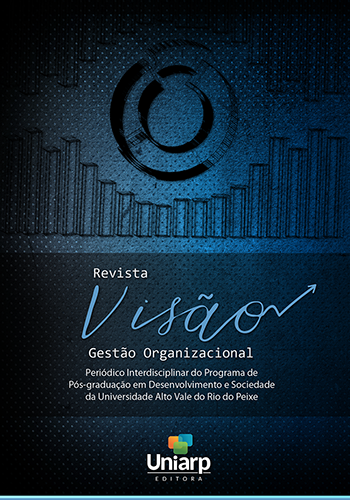IMPACTOS DO TELETRABALHO DURANTE A PANDEMIA DA COVID-19: PRINCIPAIS ACHADOS E LACUNAS DE PESQUISA
IMPACTS OF TELEWORK DURING THE COVID-19 PANDEMIC: MAIN FINDINGS AND RESEARCH GAPS
DOI:
https://doi.org/10.33362/visao.v12i1.2983Palavras-chave:
Teletrabalho., Bibliometria., Pandemia., Saúde do trabalhador.Resumo
A COVID-19 impactou diretamente a vida do trabalhador e das organizações em todo o mundo, e, impulsionado pela necessidade de isolamento social, o teletrabalho tornou-se a principal ferramenta de manutenção das atividades laborais. Assim, o debate sobre essa modalidade ganhou destaque, e fomentou o interesse de pesquisadores, tornando oportuna sua análise e sistematização. Diante disso, o objetivo central desta pesquisa foi analisar o panorama da produção científica acerca do teletrabalho durante a pandemia da COVID-19, utilizando-se de uma análise bibliométrica para identificar suas características primordiais, destacando as principais tendências e linhas de pesquisa futuras. Dessa forma, o estudo identificou que: I) houve um aumento significativo de pesquisas sobre teletrabalho; II) as relações de coautoria foram categorizados em quatro clusters, com estudos, predominantemente, sobre os efeitos do teletrabalho durante a pandemia e as implicações na saúde do trabalhador; III) teletrabalho é uma temática multidisciplinar presente em mais de 24 áreas do conhecimento, com destaque para as ciências sociais que concentram a maior parte das publicações; e IV) os artigos mais relevantes, foram citados entre 88 e 293 vezes, e os fatores de impacto dos periódicos nos quais foram publicados estão entre 3.251 e 14.098. Por fim, esta pesquisa aponta que mesmo com a crescente atenção da academia, ainda são necessários estudos futuros mais aprofundados sobre teletrabalho, considerando as esferas pessoal, organizacional e social, especialmente em vista do cenário pós-pandemia e os impactos a longo prazo provocados pela crise sanitária.
Palavras-Chave: Teletrabalho. Bibliometria. Pandemia. Saúde do trabalhador.
Abstract: COVID-19 directly impacted the lives of workers and organizations around the world, and, driven by the need for social isolation, telecommuting has become the main tool for maintaining work activities. Thus, the debate on this modality gained prominence, and fostered the interest of researchers, making its analysis and systematization timely. In view of this, the main objective of this research was to analyze the panorama of scientific production on telecommuting during the COVID-19 pandemic, using a bibliometric analysis to identify its main characteristics, highlighting the main trends and lines of future research. Thus, the study identified that: I) there was a significant increase in research on telework; II) co-authorship relationships were categorized into four clusters, with studies predominantly on the effects of telework during the pandemic and the implications for workers' health; III) telework is a multidisciplinary theme present in more than 24 areas of knowledge, with emphasis on the social sciences that concentrate most of the publications; and IV) the most relevant articles were cited between 88 and 293 times, and the impact factors of the journals in which they were published are between 3,251 and 14,098. Finally, this research points out that even with the growing attention of the academy, more in-depth future studies on telework are still necessary, considering the personal, organizational and social spheres, especially in view of the post-pandemic scenario and the long-term impacts caused by the health crisis.
Keywords: Telework. Bibliometry. Pandemic. Worker's health.
Referências
BELZUNEGUI, A.; ERRO, A.; PASTOR, I. The telework as an organizational innovation in the entities of the third sector. Journal of Electronic Commerce in Organizations, v. 12, n. 1, p. 1-15, 2014. DOI. 10.4018/jeco.2014010101. Disponível em: https://www.igi-global.com/gateway/article/108838. Acesso em 23 dez. 2022.
BELZUNEGUI-ERASO, A.; ERRO-GARCÉS, A. Teleworking in the context of the Covid-19 crisis. Sustainability (Switzerland), v. 12, n. 9, p. 1–18, 2020. DOI: 10.3390/su12093662. Disponível em: https://www.mdpi.com/2071-1050/12/9/3662. Acesso em 20 out. 2022.
CAMPISI, T.; et al. The impact of covid-19 pandemic on the resilience of sustainable mobility in sicily. Sustainability (Switzerland), v. 12, n. 21, p. 1–25, 2020. DOI: 10.3390/su12218829. Disponível em: https://www.mdpi.com/2071-1050/12/21/8829. Acesso em 20 out. 2022.
CARILLO, K.; et al. Adjusting to epidemic-induced telework: empirical insights from teleworkers in France. European Journal of Information Systems, v. 30, n. 1, p. 69–88, 2021. DOI: 10.1080/0960085X.2020.1829512. Disponível em: https://www.tandfonline.com/doi/abs/10.1080/0960085X.2020.1829512?journalCode=tjis2. Acesso em 20 out. 2022.
CARROLL, N.; CONBOY, K. Normalising the “new normal”: Changing tech-driven work practices under pandemic time pressure. International Journal of Information Management, v. 55, p. 102186, 2020. DOI: 10.1016/j.ijinfomgt.2020.102186. Disponível em: https://www.sciencedirect.com/science/article/pii/S0268401220310252. Acesso em 20 out. 2022.
DE MACÊDO, T. A. M.; et al. Ergonomics and telework: A systematic review. Work, v. 66, n. 4, p. 777–788, 2020. DOI: 10.3233/WOR-203224. Disponível em: https://content.iospress.com/articles/work/wor203224. Acesso em 20 out. 2022.
DONTHU, N., et al. How to conduct a bibliometric analysis: An overview and guidelines. Journal of Business Research, v. 133, p. 285-296, 2021. DOI: 10.1016/j.jbusres.2021.04.070. Disponível em: https://www.sciencedirect.com/science/article/pii/S0148296321003155. Acesso em 23 dez. 2022.
FAVALE, T.; et al. Campus traffic and e-Learning during COVID-19 pandemic. Computer Networks, v. 176, 2020. DOI: 10.1016/j.comnet.2020.107290. Disponível em: https://www.sciencedirect.com/science/article/pii/S1389128620306046. Acesso em 20 out. 2022.
FILARDI, F.; CASTRO, R. M. P.; ZANINI, M. T. F. Vantagens e desvantagens do teletrabalho na administração pública: análise das experiências do Serpro e da Receita Federal. Cad. EBAPE.BR, v. 18, n. 1, p. 28-46, 2020. DOI: 10.1590/1679-395174605. Disponível em: https://bibliotecadigital.fgv.br/ojs/index.php/cadernosebape/article/view/74605. Acesso em 23 dez. 2022.
FUJINO, Y.; et al. Protocol for a Nationwide Internet-based Health Survey of Workers During the COVID-19 Pandemic in 2020. Journal of UOEH, v. 43, n. 2, p. 217–225, 2021. DOI: 10.7888/juoeh.43.217. Disponível em: https://pubmed.ncbi.nlm.nih.gov/34092766. Acesso em 20 out. 2022.
GALLETTA, S.; MAZZÙ, S.; NACITI, V. A bibliometric analysis of ESG performance in the banking industry: From the current status to future directions. Research in International Business and Finance, v. 62, p. 101684, 2022. DOI: 10.1016/j.ribaf.2022.101684. Disponível em: https://www.sciencedirect.com/science/article/abs/pii/S0275531922000721. Acesso em 23 dez. 2022.
GEMELLI, C. E.; FRAGA, A. M.; PRESTES, V. A. Produção científica em relações de trabalho e gestão de pessoas (2000/2017). Contextus – Revista Contemporânea de Economia e Gestão, v. 17, n. 2, p. 222-248, 2019. DOI: 10.19094/contextus.v17i2.41214. Disponível em: http://www.spell.org.br/documentos/ver/54485. Acesso em 23 dez. 2022.
GOULART, J. O. Teletrabalho: alternativa de trabalho flexível. 1 ed. Brasília: SENAC-DF, 2009.
GRANGE, E. S.; et al. Responding to COVID-19: The UW Medicine Information Technology Services Experience. Applied Clinical Informatics, v. 11, n. 2, p. 265–275, 2020. DOI: 10.1055/s-0040-1709715. Disponível em: https://www.ncbi.nlm.nih.gov/pmc/articles/PMC7141898/. Acesso em 20 out. 2022.
GRANT, C. A.; WALLACE, L. M.; SPURGEON, P. C. An exploration of the psychological factors affecting remote e-worker's job effectiveness, well-being and work-life balance. Employee Relations, v. 35, n. 5, p. 527-546, 2013. DOI: 10.1108/ER-08-2012-0059. Disponível em: https://www.emerald.com/insight/content/doi/10.1108/ER-08-2012-0059/full/html. Acesso em 23 dez. 2022.
ISHIMARU, T.; FUJINO, Y. Association between work style and presenteeism in the Japanese service sector. Journal of Occupational Health, v. 63, n. 1, p. 1–7, 2021. DOI: 10.1002/1348-9585.12211. Disponível em: https://onlinelibrary.wiley.com/doi/10.1002/1348-9585.12211. Acesso em 20 out. 2022.
ISHIMARU, T.; et al. Workplace measures against COVID-19 during the winter third wave in Japan: Company size-based differences. Journal of Occupational Health, v. 63, n. 1, p. 1–6, 2021. DOI: 10.1002/1348-9585.12224. Disponível em: https://onlinelibrary.wiley.com/doi/10.1002/1348-9585.12224. Acesso em 20 out. 2022.
JARDIM, C. C. S. O teletrabalho e suas atuais modalidades. 1 ed. São Paulo: LTr, 2004.
JAY, J.; et al. Neighbourhood income and physical distancing during the COVID-19 pandemic in the United States. Nature Human Behaviour, v. 4, n. 12, p. 1294–1302, 2020. DOI: 10.1038/s41562-020-00998-2. Disponível em: https://www.nature.com/articles/s41562-020-00998-2. Acesso em 20 out. 2022.
KACHI, Y.; et al. Association between maternity harassment and depression during pregnancy amid the COVID-19 state of emergency. Journal of Occupational Health, v. 63, n. 1, p. 2–9, 2021. DOI: 10.1002/1348-9585.12196. Disponível em: https://onlinelibrary.wiley.com/doi/10.1002/1348-9585.12196. Acesso em 20 out. 2022.
KNIFFIN, K. M.; et al. COVID-19 and the workplace: Implications, issues, and insights for future research and action. American Psychologist, v. 76, n. 1, p. 63–77, 2021. DOI: 10.1037/amp0000716. Disponível em: https://psycnet.apa.org/fulltext/2020-58612-001.html. Acesso em 20 out. 2022.
KONRADT, U.; SCHMOOK, R.; MALECKE, M. Impacts of telework on individuals, organizations and families: a critical review. International Review of Industrial and Organizational Psychology, v. 15, p. 63-99, 2000.
KOYAMA, T.; et al. Prolonged sedentary time under the state of emergency during the first wave of coronavirus disease 2019: Assessing the impact of work environment in Japan. Journal of Occupational Health, v. 63, n. 1, p. 1–9, 2021. DOI: 10.1002/1348-9585.12260. Disponível em: https://onlinelibrary.wiley.com/doi/10.1002/1348-9585.12260. Acesso em 20 out. 2022.
KUBO, Y.; et al. A cross-sectional study of the association between frequency of telecommuting and unhealthy dietary habits among Japanese workers during the COVID-19 pandemic. Journal of Occupational Health, v. 63, n. 1, p. 1–9, 2021. DOI: 10.1002/1348-9585.12281. Disponível em: https://onlinelibrary.wiley.com/doi/10.1002/1348-9585.12281. Acesso em 20 out. 2022.
LEWIS, R. A. The influence of information technology on telework: the experiences of teleworkers and their non-teleworking colleagues in a French Public Administration. Journal of Information and Education Technology, v. 3, n. 1, p. 32-35, 2013. DOI: 10.7763/IJIET.2013.V3.229. Disponível em: http://www.ijiet.org/show-35-181-1.html. Acesso em 23 dez. 2022.
LOSEKANN, R. G. C. B.; MOURÃO, H. C. Desafios do teletrabalho na pandemia COVID-19: quando o home vira office. Caderno de Administração, v. 28, p. 71-75, 2020. DOI: 10.4025/cadadm.v28i0.53637. Disponível em: https://periodicos.uem.br/ojs/index.php/CadAdm/article/view/53637. Acesso em 23 dez. 2022.
MANZO, L. K. C.; MINELLO, A. Mothers, childcare duties, and remote working under COVID-19 lockdown in Italy: Cultivating communities of care. Dialogues in Human Geography, v. 10, n. 2, p. 120–123, 2020. DOI: 10.1177/2043820620934268. Disponível em: https://journals.sagepub.com/doi/10.1177/2043820620934268. Acesso em 20 out. 2022.
MATSUGAKI, R.; et al. Low back pain and telecommuting in Japan: Influence of work environment quality. Journal of occupational health, v. 64, n. 1, p. e12329, 2022. DOI: 10.1002/1348-9585.12329. Disponível em: https://onlinelibrary.wiley.com/doi/10.1002/1348-9585.12329. Acesso em 20 out. 2022.
MINOURA, A.; et al. Increased work from home and low back pain among japanese desk workers during the coronavirus disease 2019 pandemic: A cross-sectional study. International Journal of Environmental Research and Public Health, v. 18, n. 23, 2021. DOI: 10.3390/ijerph182312363. Disponível em: https://www.ncbi.nlm.nih.gov/pmc/articles/PMC8657068/. Acesso em 20 out. 2022.
MOLINO, M.; et al. Wellbeing costs of technology use during COVID-19 remote working: An investigation using the Italian translation of the technostress creators scale. Sustainability (Switzerland), v. 12, n. 15, p. 1–20, 2020. DOI: 10.3390/su12155911. Disponível em: https://www.mdpi.com/2071-1050/12/15/5911. Acesso em 20 out. 2022.
MORENO, M. J. A. El teletrabajo en las organizaciones: análisis de sus benefícios y barreras en las empresas españolas. Cuadernos de Gestión de Información, v. 4, p. 172-187, 2014. Disponível em: https://revistas.um.es/gesinfo/article/view/221801. Acesso em 23 dez. 2022.
NAGATA, T.; ITO, D.; et al. Anticipated health effects and proposed countermeasures following the immediate introduction of telework in response to the spread of COVID-19: The findings of a rapid health impact assessment in Japan. Journal of Occupational Health, v. 63, n. 1, p. 1–15, 2021. DOI: 10.1002/1348-9585.12198. Disponível em: https://onlinelibrary.wiley.com/doi/10.1002/1348-9585.12198. Acesso em 20 out. 2022.
NAGATA, T.; NAGATA, M.; et al. Intensity of Home-Based Telework and Work Engagement During the COVID-19 Pandemic. Journal of occupational and environmental medicine, v. 63, n. 11, p. 907–912, 2021. DOI: 10.1097/JOM.0000000000002299. Disponível em: https://journals.lww.com/joem/Fulltext/2021/11000/Intensity_of_Home_Based_Telework_and_Work.1.aspx. Acesso em 20 out. 2022.
NIU, Q.; et al. Health effects of immediate telework introduction during the COVID-19 era in Japan: A cross-sectional study. PLoS ONE, v. 16, n. 10, p. 1–14, 2021. DOI: 10.1371/journal.pone.0256530. Disponível em: https://journals.plos.org/plosone/article?id=10.1371/journal.pone.0256530. Acesso em 20 out. 2022.
OAKMAN, J.; et al. A rapid review of mental and physical health effects of working at home: how do we optimise health? BMC Public Health, v. 20, n. 1, p. 1–13, 2020. DOI: 10.1186/s12889-020-09875-z. Disponível em: https://bmcpublichealth.biomedcentral.com/articles/10.1186/s12889-020-09875-z. Acesso em 20 out. 2022.
OIT - Organização Internacional do Trabalho. Teleworking during the COVID-19 pandemic and beyond A practical guide, 2020. Disponível em: <https://www.ilo.org/wcmsp5/groups/public/---ed_protect/---protrav/---travail/documents/instructionalmaterial/wcms_751232.pdf>. Acesso em 23 de dez. de 2022.
OTSUKA, S.; et al. A Cross-Sectional Study of the Mismatch Between Telecommuting Preference and Frequency Associated With Psychological Distress Among Japanese Workers in the COVID-19 Pandemic. Journal of occupational and environmental medicine, v. 63, n. 9, p. e636–e640, 2021. DOI: 10.1097/JOM.0000000000002318. Disponível em: https://pubmed.ncbi.nlm.nih.gov/34491971/. Acesso em 20 out. 2022.
PALMATIER, R. W.; HOUSTON, M. B.; HULLAND, J. Review articles: Purpose, process, and structure. Journal of the Academy of Marketing Science, v. 46, p. 1-5, 2018. DOI: 10.1007/s11747-017-0563-4. Disponível em: https://link.springer.com/article/10.1007/s11747-017-0563-4#citeas. Acesso em 23 dez. 2022.
PIERPAOLI, M.; RUELLO, M. L. Indoor Air Quality: A bibliometric study. Sustainability (Switzerland), v. 10, n. 11, 2018. DOI: 10.3390/su10113830. Disponível em: https://www.mdpi.com/2071-1050/10/11/3830. Acesso em 20 out. 2022.
RAIŠIENE, A. G.; et al. Working from home-Who is happy? A survey of Lithuania’s employees during the COVID-19 quarantine period. Sustainability (Switzerland), v. 12, n. 13, 2020. DOI: 10.3390/su12135332. Disponível em: https://www.mdpi.com/2071-1050/12/13/5332. Acesso em 20 out. 2022.
ŠAGÁT, P.; et al. Impact of COVID-19quarantine on low back pain intensity, prevalence, and associated risk factors among adult citizens residing in riyadh (Saudi Arabia): A cross-sectional study. International Journal of Environmental Research and Public Health, v. 17, n. 19, p. 1–13, 2020. DOI: 10.3390/ijerph17197302. Disponível em: https://www.mdpi.com/1660-4601/17/19/7302. Acesso em 20 out. 2022.
SALMERÓN-MANZANO, E.; MANZANO-AGUGLIARO, F. The role of smart contracts in sustainability: Worldwide research trends. Sustainability (Switzerland), v. 11, n. 11, 2019. DOI: 10.3390/su11113049. Disponível em: https://www.mdpi.com/2071-1050/11/11/3049. Acesso em 20 out. 2022.
SHARMA, M.; et al. Developing a framework for enhancing survivability of sustainable supply chains during and post-COVID-19 pandemic. International Journal of Logistics Research and Applications, v. 25, n. 4–5, p. 433–453, 2022. DOI: 10.1080/13675567.2020.1810213. Disponível em: https://www.tandfonline.com/doi/full/10.1080/13675567.2020.1810213. Acesso em 20 out. 2022.
STEIL, A. V.; BARCIA, R. M. Um modelo para análise da prontidão organizacional para implantar o teletrabalho. Revista de Administração, v. 36, n. 1, p. 74-84, 2001. Disponível em: http://rausp.usp.br/wp-content/uploads/files/v36n1p74a84.pdf. Acesso em 23 dez. 2022.
TAHAVORI, Z. Teleworking in the National Library and Archives of Iran: teleworkers’ atitudes. Journal of Librarianship and Information Science, v. 47, n. 4, p. 1-15, 2014. DOI: 10.1177/0961000614532. Disponível em: https://journals.sagepub.com/doi/10.1177/0961000614532676. Acesso em 23 dez. 2022.
TEZUKA, M.; et al. Association between Abrupt Change to Teleworking and Physical Symptoms during the Coronavirus Disease 2019 (COVID-19) Emergency Declaration in Japan. Journal of Occupational and Environmental Medicine, v. 64, n. 1, p. 1–5, 2022. DOI: 10.1097/JOM.0000000000002367. Disponível em: https://journals.lww.com/joem/Fulltext/2022/01000/Association_Between_Abrupt_Change_to_Teleworking.1.aspx. Acesso em 20 out. 2022.
VAN ECK, N. J.; WALTMAN, L. Software survey: VOSviewer, a computer program for bibliometric mapping. Scientometrics, v. 84, n. 2, p. 523–538, 2010. DOI: 10.1007/s11192-009-0146-3. Disponível em: https://link.springer.com/article/10.1007/s11192-009-0146-3. Acesso em 20 out. 2022.
VILARINHO, K. P. B.; PASCHOAL, T.; DEMO, G. Teletrabalho na atualidade: quais são os impactos no desempenho profissional, bem-estar e contexto de trabalho? Revista do Serviço Público, v. 72, n. 1, p. 133-162, 2021. DOI: 10.21874/rsp.v72i01.4938. Disponível em: https://revista.enap.gov.br/index.php/RSP/article/view/4938. Acesso em 23 dez. 2022.
WAIZENEGGER, L.; et al. An affordance perspective of team collaboration and enforced working from home during COVID-19. European Journal of Information Systems, v. 29, n. 4, p. 429–442, 2020. DOI: 10.1080/0960085X.2020.1800417. Disponível em: https://www.tandfonline.com/doi/full/10.1080/0960085X.2020.1800417. Acesso em 20 out. 2022.
WAKAIZUMI, K.; et al. Sitting for long periods is associated with impaired work performance during the COVID-19 pandemic. Journal of Occupational Health, v. 63, p. 1–12, 2021. DOI: 10.1002/1348-9585.12258. Disponível em: https://onlinelibrary.wiley.com/doi/10.1002/1348-9585.12258. Acesso em 20 out. 2022.
WANG, B.; et al. Achieving Effective Remote Working During the COVID-19 Pandemic: A Work Design Perspective. Applied Psychology, v. 70, n. 1, p. 16–59, 2021. DOI: 10.1111/apps.12290. Disponível em: https://iaap-journals.onlinelibrary.wiley.com/doi/10.1111/apps.12290. Acesso em 20 out. 2022.
WATANABE, C.; et al. Relationship between alcohol consumption and telecommuting preference-practice mismatch during the COVID-19 pandemic. Journal of occupational health, v. 64, n. 1, p. e12331, 2022. DOI: 10.1002/1348-9585.12331. Disponível em: https://onlinelibrary.wiley.com/doi/10.1002/1348-9585.12331. Acesso em 20 out. 2022.
XIAO, Y.; et al. Impacts of Working from Home during COVID-19 Pandemic on Physical and Mental Well-Being of Office Workstation Users. Journal of Occupational and Environmental Medicine, v. 63, n. 3, p. 181–190, 2021. DOI: 10.1097/JOM.0000000000002097. Disponível em: https://www.ncbi.nlm.nih.gov/pmc/articles/PMC7934324. Acesso em 20 out. 2022.
ZOLTOWSKI, A. P. C., et al. Qualidade metodológica das revisões sistemáticas em periódicos de psicologia brasileiros. Psicologia – Teoria e Pesquisa, v. 30, n. 1, p. 97-104, 2014. DOI: 10.1590/S0102-37722014000100012. Disponível em: https://www.scielo.br/j/ptp/a/L7CvnCh4KJVhgcnkLKnTtFc/?lang=pt. Acesso em 23 dez. 2022.
Downloads
Publicado
Como Citar
Edição
Seção
Licença
Copyright (c) 2023 Caitto Arroyo Vasconcellos, Ayara Leticia Bentes da Silva, Greyce Emanuelle Moreira de Oliveira Lisboa, Cristiano Descovi Schimith

Este trabalho está licenciado sob uma licença Creative Commons Attribution-NonCommercial 4.0 International License.
Estou ciente de que, através da submissão voluntária de meu texto ao corpo editorial da revista Visão, editada pela Universidade Alto Vale do Rio do Peixe - UNIARP, estou concedendo à Universidade Alto Vale do Rio do Peixe a autorização de publicar o respectivo texto na revista a título não oneroso e declarando a originalidade do texto e sua não submissão simultanea a qualquer outro periódico, em meu nome e em nome dos demais coautores, se eventualmente existirem.Reitero que permaneço como legítimo titular de todos os direitos patrimoniais que me são inerentes na condição de autor. Comprometo-me também a não submeter este mesmo texto a qualquer outro periódico no prazo de, pelo menos, um (1) ano. Declaro estar ciente de que a não observância deste compromisso acarretará em infração e conseqüente punição tal como prevista na Lei de Proteção de Direitos Autorias (Nº9609, de 19/02/98).












 Revista Visão: Gestão Organizacional está licenciado com uma Licença
Revista Visão: Gestão Organizacional está licenciado com uma Licença 